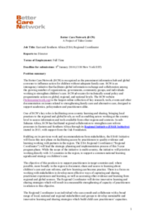Displaying 1631 - 1640 of 2496
This article from the Child Law Practice Today July/August 2017 Issue on Kinship Care outlines policy and practice tips for supporting grandparents raising grandchildren due to the current opioid and heroin epidemic in the US.
In this article from the Child Law Practice Today July/August 2017 Issue on Kinship Care, Los Angeles Judge Michael Nash, Ret. shares court and agency strategies to engage and support relatives for children and families involved in the child welfare system in the US.
Providing relative caregivers the same financial benefits and supports as nonrelative foster caregivers is the focus of ongoing US federal litigation described in this article from the Child Law Practice Today July/August 2017 Issue on Kinship Care. The litigation addresses the equitable treatment of relatives who care for children in the child welfare system.
This article from the Child Law Practice Today July/August 2017 Issue on Kinship Care describes a national campaign launched by the Annie E. Casey Foundation, with other national stakeholders, to transform foster parenting by changing the way systems and communities partner with foster parents to help children stay safe, heal, and thrive in their own families and communities. The article highlights the considerations identified by kinship foster families as fundamental to feeling supported by child welfare systems and providing the best possible care.
This article from the Child Law Practice Today July/August 2017 Issue on Kinship Care summarizes seven steps to create a kin-first culture—one in which child welfare stakeholders consistently promote kinship placement, help children in foster care maintain connections with their families, and tailor services and supports to the needs of kinship foster families.
This article from the Child Law Practice Today July/August 2017 Issue on Kinship Care explores kinship care in the US, including its benefits to children and families.
The current study tests the ‘overburdening’ hypothesis that examines whether taking on the demands of work and school at the same time could overwhelm and actually hinder the healthy development of youth as they transition from foster care.
This sudy sought to deepen understanding of the underlying patterns of services receipt of the John F. Chafee Foster Care Independence Program (CFCIP) to prepare for youth’s successful transition to adulthood. The authors used multi-level latent class analysis (MLCA) to identify underlying combinations of service receipt that may be influenced by youth-level and state-level characteristics.
In this piece for Youth Today, Richard Wexler - executive director of the National Coalition for Child Protection Reform - calls out child protection policies in the US for too often unnecessarily removing children from poor families due to parental mental illness and what the child protection agencies deem as inability to raise children "independently."
BCN is seeking a Regional Coordinator for our Eastern and Southern Africa Regional Initiative on Children without Appropriate Family Care.

